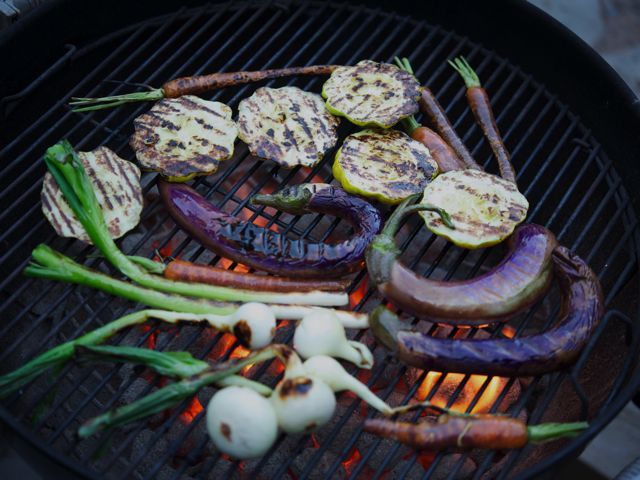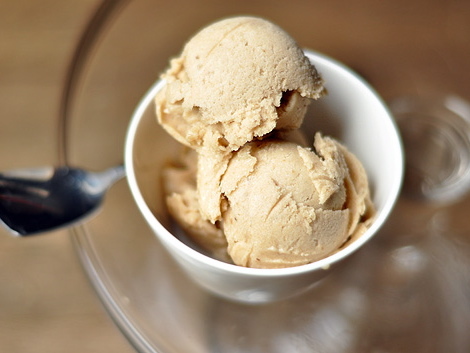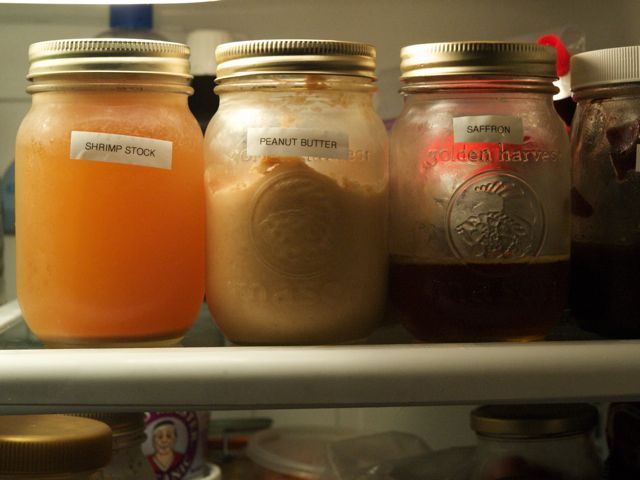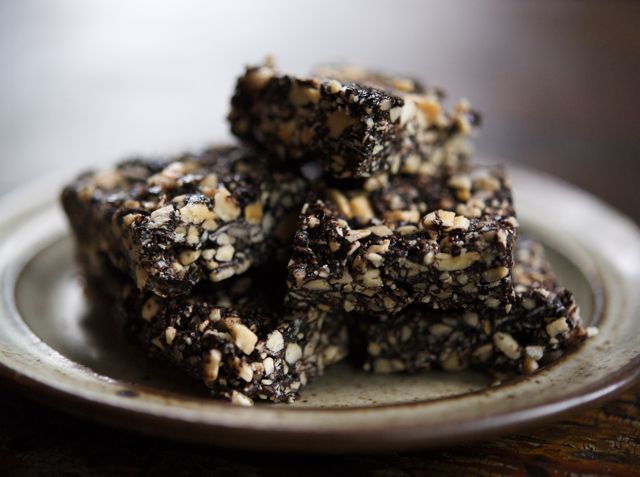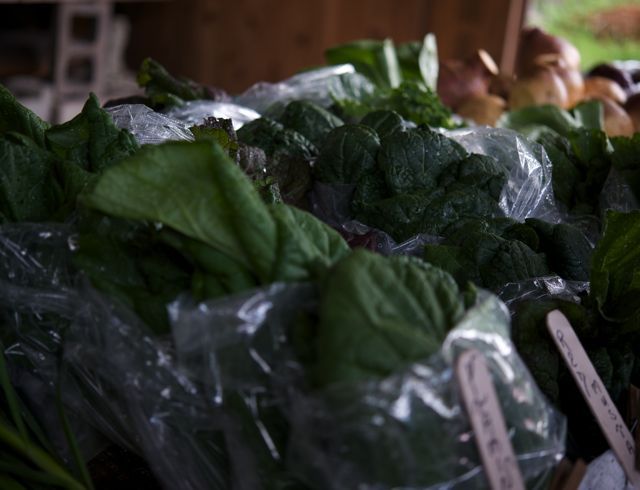For much of the year, we follow a regular Saturday schedule: the dump; the farmers market in Barryville; Riverbrook Farm, Silver Heights Nursery and the dairy farm in Cochecton. It's an intense session of locavore foraging and so deeply satisfying. Whatever produce we're not getting from our own garden we get from Riverbrook Farm (along with fresh eggs and some goat and lamb meat), but they don't grow fruit, so we've been lucky to have a steady stream from some lovely people at the Barryville farmers market. We've had red currants, gooseberries, strawberries, apricots, blackberries, at least 8 varieties of raspberries, all kinds of plums (golden, red, sugar, black, Italian), delectable peaches (white and yellow) and now crisp, flavorful apples have begun to make an appearance. My pantry shelves hold jars of plum preserves. Tucked away in my freezer, along with the tomato sauce, are liter freezer bags filled with blackberries, raspberries and peaches. The trick to freezing berries is to spread them first on parchment-lined cookie sheets. Then, once frozen, slide the little nuggets into ziploc freezer bags or other airtight containers. This way, all year long you can have sorbet, ice cream, smoothies and even pie that taste of sweet summer. Speaking of sorbet, I made one with blackberries that was so divine, I can't resist making it again right away.
Read More...
Health
Twitter @glutton4life
8.1.10 Grillin'
The fruits of one's own garden just seem to taste sweeter. Our first patty pan squash, Japanese eggplants and scallions went on the grill, along with red carrots and sweet onions from the farm. With a radicchio salad in a creamy dressing, that was all we needed for dinner the other night. I made a dipping sauce for the vegetables with an earthy red miso and it truly was perfection. A grill can really change the way you eat, especially if you live in LA or some other temperate climate. As irresistible as that charred flavor can be, I want you to be aware that too much blackened food is not good for you. Burning food produces a group of substances (polycyclic aromatic hydrocarbons) that are associated with cancer, cardiovascular toxicity and immune system suppression, among other adverse effects. So avoid extreme charring of your food, and don't eat from the grill every day. Moderation really is the key. (Except when it comes to exercise, of course.) But don't despair! You can use you grill to cook in a number of ways that don't involve charring but still infuse your food with that delicious smoky flavor. Low and slow, as in our pulled pork for instance, or indirect cooking, which really is the best way to do chicken or other foods that tend to burn quickly.
Read More...
Read More...
7.29.10 Illin'
Few things are worse than a summer cold. The usual trajectory for me is straight from a terrible sore throat to an aggravated chest cough. Lying in bed, feverish and tangled in the sheets, there's nothing I crave more than an icy lemonade. So I stumbled into the kitchen, squeezed 2/3 cup of lemon juice and poured that along with an almost equal amount of raw blue agave nectar into the blender. Then I filled it up with ice, added a cup of water and processed it into a crystalline slurpie. Heaven. With that and a good book (and an antibiotic if need be), I'm on the mend.
Read More...
Read More...
7.18.10 Liquid Gold
Once you make chicken stock using this recipe, I promise you'll never want to go back to that stuff in the box, no matter how organic it is or how convenient it seems. You can make an enormous vat of this and freeze small containers or even ice cube trays full of it to use for months. If space is at a premium in your freezer, you can boil the stock down to a concentrated and syrupy demi-glace which can later be reconstituted into stock by adding water. I got this recipe from Nourishing Traditions and it's really quite similar to most chicken stock recipes you'll find, with one key exception: you cook it over very low heat for at least 6 and as many as 24 hours! Turns out this make a huge difference in the flavor, color and consistency of the stock. It's rich, golden, unctuous without being greasy and highly flavored. Of course it helps if you are using a whole chicken, or lots of good bony parts, including necks and feet.
Read More...
Read More...
7.1.10 Hummus With a Kick
This week, a friend asked me to post a recipe for hummus. This is a somewhat controversial issue: just ask someone from Jerusalem or Beirut. People in the Middle East are totally obsessed with this creamy stuff, as you can see by the gigantic vat above (weighing 23,520 pounds) prepared by Lebanese chefs who set the latest Guinness world record—beating Israel, which had previously beat Lebanon. So there’s the Galilee hummus or the Jerusalem kind, with or without fava beans, topped with warm chickpeas or served without. I suppose it’s like masala or gumbo, with every good chef developing his own version. Mine was inspired by a horseradish-laced hummus I once bought at Whole Foods. I was never able to find it again and, after hankering for it for months, I finally concocted the version which I humbly offer you here.
Read More...
Read More...
6.26.10 Condimental: Playing Ketchup
I love all the trappings of an American summer barbecue—pickles, ketchup, chips, mayonnaise. But now that I've become so conscious of what goes into the industrialized versions of these classics, I will never set out a bottle of Heinz again. It's loaded with high fructose corn syrup and corn syrup, salt and "natural flavoring," which could easily mean MSG. So sad, considering the origins of this wonderful tomato condiment. The word "ketchup" (also "catsup") derives from the Chinese ke-tsiap for pickled-fish sauce, a widespread condiment since ancient times. (See here for my reference to its Roman origins.) The English added mushrooms, nuts and even oysters to it; the Americans added tomatoes from Mexico. So ketchup was originally a lacto-fermented sauce, full of nutrition, enzymes and good bacteria, and not the sugar-laden, heat-processed junk we consume to the tune of half a billion bottles annually. Guess where I'm going with all this? Straight to making our own ketchup. It's easy, really good and keeps in the fridge just like your Heinz. But plopping it on your kids' burgers won't send their blood sugar through the roof or rot their teeth. You can also modify this ketchup to suit your own tastes: add a little curry, or a couple of minced jalapeños, or some toasted, ground fennel seeds. The basic recipe tastes pretty close to the bottled stuff, though it's a little funkier, more complex in a palate-pleasing, umami way.
Read More...
Read More...
6.19.10 Bananarama
I know, I know. Another creamy, icy, indulgent treat. Don't be mad at me. It's that time of year. Besides this rich and delicious ice cream is completely dairy-free and can be made with no added sweetener. Its secret ingredient? Bananas! I happen to be a huge fan of banana ice cream, so when my sister-in-law forwarded me a year-old link to this recipe on Apartment Therapy's The Kitchn, I was excited to try it. Theirs called simply for frozen bananas whipped in a food processor, but I added a few extra ingredients in very small quantities—maple syrup, lemon juice, crème fraîche and cinnamon. Feel free to customize it according to your own flavor fetishes, but consider peanut butter, chocolate, cardamom, coconut milk and lime (but probably not all together). And remember, bananas are a great source of potassium, magnesium and vitamin C. They're also full of fructooligosaccharide, a prebiotic that helps colonize your intestine with good bacteria. As if you needed another reason to try this...
Read More...
Read More...
6.18.10 Condimental: From Scratch
Welcome to my 200th post. (Although my site didn't go live until December, I had a backlog of posts dating to last July.) Those of you who frequent other blogs may notice that I update quite often. I've really been enjoying pouring my passion out on this page, and sharing with you all my recent nutritional discoveries. It's as though the scales have fallen from my eyes and I see the world of food in a new way. I find it a little challenging to write about things like fats, raw milk, lacto-fermentation, grass-fed beef, etc. because I imagine some of you don't have access to these things—or may not be ready to incorporate them into your lives. But as I move closer to the earth and closer to the traditional way of using what nature offers us—without the tyranny and destruction of industrialized agriculture and mass processing—I am compelled to tell you about how wonderful it is! I fervently hope I can continue to pique your interest and your palate. This shot of my fridge, above, and the ones that follow, are as good an indication as any of the transformation of my kitchen. I am so much more in control of what goes into my body, because I'm making my own mayonnaise (from farm-fresh egg yolks and cold-pressed olive and peanut oils); and my own stocks and syrups and nut butters and pickles.
Read More...
Read More...
6.15.10 Chew On This
Growing up in Santa Cruz, still a hippie mecca to this day, I was exposed early on to all manner of what used to be known as "health foods"—sprouts, carob, smoothies, kefir, whole grain sourdough bread. Maybe that's why I still enjoy trawling about crunchy food co-ops, peering at bags of sesame sticks, bins of millet and containers of powdered spirulina. There is almost always an assortment of carob-covered items (raisins, almonds, ginger) and sometimes these little nuggets, studded with lots of goodies. I love carob's dark, earthy richness; its mild bitterness and distinct winey taste hold up to chocolate's complexity. Carob is a species of flowering evergreen tree in the pea family that is cultivated for its edible seed pods, which are also known as "St. John's bread" because John the Baptist was said to have subsisted on them in the wilderness. Supposedly they also fed Mohammed's armies. The pod can be elongated, compressed, straight or curved and takes a full year to develop and ripen. It is the dried and sometimes roasted pod that we eat, and not the peas or seeds inside. These are called locust beans and are used for animal feed or as the source of locust bean gum, a thickening agent that is an ingredient in many processed foods.
Read More...
Read More...
6.14.10 Green Light
Spinach plucked fresh from the garden is one of the great joys at this time of year. Thought to have originated in ancient Persia, Arab traders carried spinach into India, from where it was introduced to China. The earliest record of spinach is in Chinese from around 647 AD. When Catherine de’Medici, born in Florence, became queen of France, she insisted that spinach be served at every meal. That’s why, to this day, dishes made with spinach are known as "Florentine."Highly nutritious and full of antioxidants, spinach is a rich source of vitamin A, vitamin C, vitamin E, vitamin K, magnesium, manganese, folate, betaine, iron, vitamin B2, calcium, potassium, vitamin B6, folic acid, copper, protein, phosphorous, zinc, niacin, selenium and omega-3 fatty acids. No wonder it made Popeye so strong! Consider this: a 180 gram serving of boiled spinach contains 6.43 mg of iron, versus the 4.42 mg in a 170 gram ground beef patty. However, spinach contains oxalic acid, which binds with iron and prevents its absorption, so it is best eaten with foods high in vitamin C and calcium that help it be absorbed by the body. These include meat, fish, poultry, dairy, citrus, cantaloupe, strawberries, broccoli, brussels sprouts, tomato, potato, red peppers and white wine. The dark green, crinkly spinach is called Savoy; there is also a kind with flat, smoother leaves; and there is a hybrid type that is somewhere in between. To maximize its nutrients, spinach is best eaten when fresh, lightly steamed or blanched. But I also love it creamed (which means somewhat more cooked down) and raw in salads.
Read More...
Read More...








